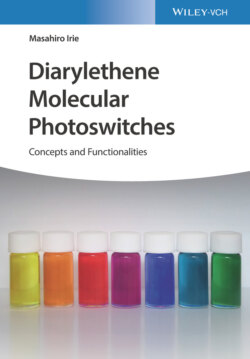Читать книгу Diarylethene Molecular Photoswitches - Masahiro Irie - Страница 9
Preface
ОглавлениеMolecules capable of reversible photoswitching between two isomers having different absorption spectra are called photochromic molecules or molecular photoswitches. The two isomers differ from each other not only in their absorption and fluorescence spectra, but also in their refractive indices, dielectric constants, oxidation/reduction potentials, and geometrical structures. These photoswitchable bistable molecules are applied to construct photonic devices, such as erasable optical memory media and optical switch elements. Although the first finding of photoswitchable molecules can be traced back to the middle of nineteenth century, they are still awaiting their time to go on the stage of photonics devices in wide use.
Digital cameras take photos by using physical phenomena of inorganic materials. Photodiodes, such as CCD (charge‐coupled device) and CMOS (complementary metal oxide semiconductor), detect photons based on photovoltaic effects and construct photo‐images. Animals and plants have no such inorganic semiconductors. In biological systems, molecular photoswitches are extensively employed in photoreceptors. Vision, for example, uses the cis‐to‐trans photoisomerization of retinal to control the conformation of rhodopsin and initiate the transduction cascade to generate neural signals, while phototaxis of Chlamydomonas is activated by the trans‐to‐cis photoisomerization of retinal in the channel rhodopsin. In plants, the photoisomerization of phytochromes plays a key role in controlling their biological activity. These ingenious uses of organic molecules for the detection of photons in biological systems indicate that molecular photoswitches have the potential to be applied in the construction of various types of photon‐working reagents and devices.
A characteristic feature of molecules is their small size (∼ 1 nm). If a single molecule would work as one‐bit memory, ultimate high‐density (1 P bit/inch2) optical memory could be realized. Conductance switches are key components of almost all electronic devices. Fabrication of single‐molecule photoswitches is the first step toward molecular electronics. Photoswitching of single‐molecule fluorescence has revolutionized fluorescence microscopy imaging. The super‐resolution technique realizes a resolution of a few tens of nanometers. For such applications, molecular photoswitches are required to possess superior properties, such as thermal stability of both isomers, fatigue resistance, high sensitivity, rapid response, and reactivity in the solid state. Among them, thermal stability and fatigue resistance are indispensable properties. Although tremendous efforts were made in the 1970–1980s to provide the thermal irreversibility to molecular photoswitches in order to apply them to optical memory media, all attempts to modify existing photoswitchable molecules failed, because there was no guiding principle on how to prepare such thermally stable molecular photoswitches.
In 1988, the serendipitous discovery of diarylmaleic anhydrides, which undergo thermally irreversible photoswitching reactions, paved the way to solve the problem. Inferring from experimental as well as theoretical analysis, the molecular design principle of thermally irreversible molecular photoswitches was established. This new class of molecular photoswitches is named “Diarylethene.” The well‐designed diarylethenes provide outstanding photoswitching performance: both isomers are thermally stable for more than 470 000 years at 30 °C, photocyclization(coloration)/photocycloreversion(decoloration) can be repeated for more than 104 cycles, the quantum yield of cyclization reaction is close to 1 (100%), and the response times of both photocyclization and photocycloreversion reactions are less than 20 ps. Many of the diarylethene derivatives undergo photoswitching reactions even in the crystalline phase. In this book, the discovery and development of diarylethenes are described comprehensively from the basic concepts to their applications.
I wish to express my deep appreciation to my colleagues, Prof. M. Morimoto, Prof. S. Kobatake, Prof. K. Matsuda, Prof. T. Fukaminato, Prof. K. Uchida, Prof. T. Kawai, Prof. T. Tsujioka, and Dr. K. Uno for their kind help and support to prepare the manuscript. Finally, I also express my thanks to my family, Setsuko, Fumi, and Hisafumi for their continual encouragement to complete this book.
December 2020
Masahiro Irie
